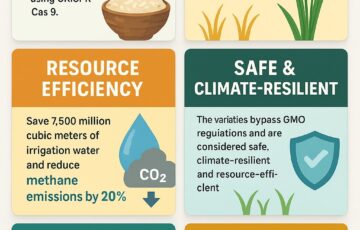Surge in Ethanol Blending: Impact on Food Prices
Surge in Ethanol Blending: Impact on Food Prices
Syllabus:
GS-3:
Environmental Pollution & Degradation , Renewable Energy , 2nd ARC
Focus:
India has met its ethanol-blending target of 20% in petrol well ahead of schedule, and the government is now aiming for a 30% ethanol-blending ratio in the coming years. However, this raises concerns regarding the diversion of sugar from food consumption to ethanol production, affecting food prices and availability.
Undstanding the Ethanol Blending Programme (EBP) in India:
1. EBP Implementation Timeline
- The Indian government initiated the Ethanol Blending Programme (EBP) in the early 2000s, primarily to address rising fossil fuel consumption and enhance sustainability.
- Initially, the EBP faced limitations, such as restrictions on the use of sugarcane juice, sugar syrup, and B-heavy molasses for ethanol production. These restrictions were later lifted, resulting in a surge in the supply of ethanol.
2.Success of EBP and Targets
- The programme has achieved significant progress over the years, with ethanol blending reaching 20% in FY25, surpassing the original target of 20% blending by 2030.
- In FY14, ethanol blending was just 5%, while by FY24, the blending rate had surged to 20%. This rapid increase is due to a steady rise in sugar diverted for ethanol and tax reductions on ethanol meant for blending.
Key points :Ethanol Blending Programme (EBP)Launched in January 2003, the Ethanol Blended Petrol (EBP) programme aims to blend ethanol with petrol to: Targets and Progress: ● E10 target: 10% ethanol blending by 2021-22. Sources of Bio Ethanol Production: ●Sugarcane: ●Maize: ●Surplus rice & damaged grains: Significance of Ethanol Blending Programme: ● Energy Security: ●Import Substitution: ●Reduction of Emissions: ○ Blending 20% ethanol in petrol reduces carbon monoxide emissions by 50% in two-wheelers and 30% in four-wheelers. ●Rural Economy & Farmer’s Income: ● Job Creation: |
Impact of Increased Ethanol Blending on Sugar Production:
1.Sugarcane Production Decline
- Sugarcane production in India, a major source for ethanol, has been on a decline since 2022, influenced by factors like red-rot disease, inconsistent rainfall, and crop flowering issues.
- As per government data, sugarcane production peaked at 490 crore tonnes in FY23 but dropped in FY24 and is expected to decline further in FY25 to 435 crore tonnes.
2.Effects on Sugar Availability
- The diversion of sugarcane for ethanol production has reduced the availability of sugar for direct consumption. This has led to an increase in sugar prices, with retail prices rising from ₹40 per kg in May 2023 to ₹45 per kg by May 2025.
- The rise in sugar prices has placed a financial burden on consumers, with some reports indicating concerns over food security due to less sugar being available for domestic use.
Government’s Measures to Counter the Supply Shortage:
1.Fair Remunerative Price (FRP) Hike
- In response to declining sugarcane production, the Indian government approved an increase in the Fair Remunerative Price (FRP) for sugarcane. This aims to protect farmers’ interests and ensure they are adequately compensated for their produce.
- However, this measure has contributed to higher sugar prices, further exacerbating the affordability issue for consumers.
2.Grain-Based Ethanol Production
- In light of the reduced sugarcane production, the government is exploring the use of grains to make up for the shortfall in ethanol production. This is seen as a temporary solution to maintain ethanol supply without further compromising food security.
Pros and Cons of Increased Ethanol Blending:
1.Environmental and Economic Benefits
- The increased ethanol blending has significant sustainability benefits, including reducing India’s reliance on fossil fuels and cutting down on oil imports.
- Ethanol is seen as a cleaner, renewable source of energy that can help reduce carbon emissions from petrol.
2.Potential Risks to Food Security
- However, the diversion of sugar and grains for ethanol production poses risks to food security, as it reduces the supply of essential food products and drives up their prices.
- This creates a tension between the government’s goals of sustainable fuel production and the need to ensure adequate food availability for consumers.
The Way Forward:
1.Balancing Food and Fuel Needs
- India’s government faces the challenge of balancing its goals of increasing ethanol blending with ensuring that food security is not compromised.
- Further diversification of ethanol production sources, such as through the use of non-food crops, could help mitigate this conflict.
2.Encouraging Technological Innovation
- Research into more efficient methods of ethanol production from non-food sources or agricultural waste could reduce the reliance on sugarcane and food grains.
- Encouraging sustainable farming practices and increasing yields from existing sugarcane crops could also help meet both fuel and food demands.
Conclusion:
The surge in ethanol blending in India, aimed at reducing fossil fuel dependence, presents both opportunities and challenges. While it helps meet environmental and energy goals, it raises concerns about food security and rising sugar prices. A balanced approach, combining innovation in ethanol production and strategic agricultural policies, is essential to ensure sustainable growth in both sectors.
Source: TH
Mains Practice Question:
Examine the socio-economic impacts of India’s increasing ethanol blending targets on food security and fuel sustainability. Suggest measures to balance both concerns effectively.






